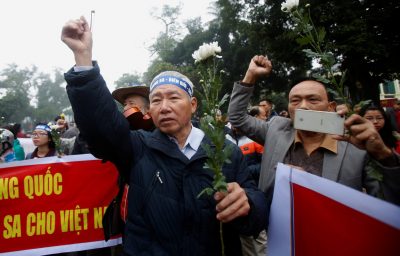Vietnam’s strategies in the South China Sea
A year ago on 12 July 2016, the Arbitral Tribunal handed down its award on the claims brought by the Philippines against China over their maritime disputes in the Spratly Islands. The Tribunal ruled unanimously on almost all of the Philippines’ claims.
If China and the Philippines had complied with the findings of the award, as required by international law, Vietnam would have been a major beneficiary for four reasons.

First, the Tribunal ruled that China’s nine-dash line claims to historic rights, other sovereign rights and jurisdiction in the South China Sea are contrary to the UN Convention on the Law of the Sea (UNCLOS) and ‘without lawful effect’. Further, the Tribunal found that UNCLOS ‘superseded any historic rights, or other sovereign rights or jurisdiction’ claimed by China that are in excess of the limits imposed in the Convention.
Second, the Tribunal ruled that none of the land features in the Spratlys are islands in terms of international law and, therefore, none of these features are entitled to a 200-nautical mile exclusive economic zone.
Third, the Tribunal found the conduct of China’s law enforcement vessels, such as ramming and the use of high-powered water cannons, breached China’s obligations under international law. In addition, China’s law enforcement vessels violated sovereign rights by interfering with commercial oil exploration operations, imposing an illegal moratorium on fishing, failing to prevent Chinese-flagged vessels from fishing illegally and preventing other fishermen from engaging in traditional fishing.
Fourth, it was found that China failed to meet its obligations to protect and preserve the maritime environment in the South China Sea by constructing artificial islands and not cooperating with other littoral states to protect and preserve the marine environment.
In sum, most of the sources of contention between Vietnam and China over sovereign rights in the South China Sea would have been eliminated if China had accepted the Arbitral Tribunal’s ruling. Further, the way would have been opened for regional cooperation to redress China’s destruction of the marine environment.
But Vietnam chose not to press the legal leverage it accrued from the Tribunal’s award. Rather, Vietnam has joined other ASEAN members in avoiding any mention of the award, preferring ‘legal and diplomatic processes’ instead. Vietnam knows only too well that any mention of the award would incur China’s diplomatic wrath.
Vietnam has not been entirely quiescent though. It is pursuing four strategies to protect its maritime claims in the South China Sea.
First, Vietnam is pursuing a ‘cooperation and struggle’ strategy with China. This entails taking actions that strengthen its claims in the South China Sea, such as building up and equipping its navy and air force to present a credible military deterrent to China.
For example, in 2016, Vietnam extended the runway on Truong Sa Lon island to enhance its maritime reconnaissance capabilities. More significantly, Vietnam reportedly deployed launchers for Israeli-manufactured Extended Range Artillery Rockets on several of its features. And according to Chinese sources, Vietnamese special forces frogmen became active in waters adjacent to China’s artificial islands.
Vietnam has also stepped up oil exploration activities in the South China Sea in cooperation with US, Spanish and Indian oil companies. This led China to abruptly cancel this year’s annual Vietnam–China friendly border defence activities in response.
Second, Vietnam has engaged China on the South China Sea at working group level, senior official level and in high-level bilateral meetings. At the same time, Vietnam has been more forthright in issuing diplomatic protests and public statements critical of Chinese actions in the area.
Third, Vietnam has been active in ASEAN in trying to forge a united front on maritime disputes with China in the South China Sea. But ASEAN’s norm of consensus has resulted in watered-down statements. For example, at ASEAN’s most recent summit in Manila in April 2017, the South China Sea section in the Chair’s Statement was reduced from eight to only two paragraphs. The statement noted, ‘we took note of concerns expressed by some leaders over recent developments in the area’ rather than the ‘serious concerns’ noted the year before.
Fourth, Vietnam’s leaders have sought and received statements of support from Japan, India and the United States on the South China Sea. These statements invariably support freedom of navigation and overflight and other lawful uses of the seas as well as the peaceful resolution of disputes without the threat or use of force or coercion, in accordance with international law, including full respect for diplomatic and legal processes.
Most recently, after US President Donald Trump received Vietnamese Prime Minister Nguyen Xuan Phuc at the White House on 31 May, they issued a joint statement that ‘called upon all parties concerned to implement their international legal obligations in good faith in any resolution to these disputes’. They highlighted the importance that parties refrain from actions that would escalate tensions, such as the militarisation of disputed features.
Imminent hostilities between China and Vietnam are unlikely. Both sides are pursuing diplomacy bilaterally and multilaterally, including through discussions on a code of conduct for the South China Sea between ASEAN member states and China. If implemented and respected, this code of conduct could dilute some of the sources of friction between China and Vietnam in the South China Sea where the Tribunal’s ruling has been unable to.
Carlyle A. Thayer is an Emeritus Professor at the University of New South Wales, Australian Defence Force Academy, Canberra.
No comments:
Post a Comment